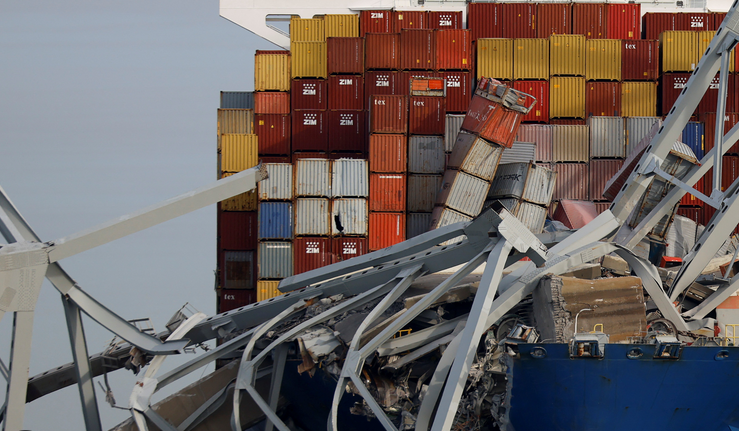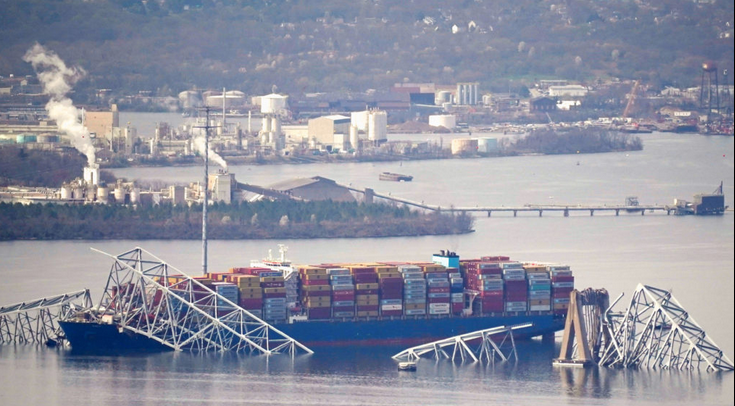A huge cargo ship collided with the Francis Scott Key Bridge in Baltimore early on Tuesday, leading to the collapse of the 1.6-mile long bridge, resembling a heap of toothpicks, and resulting in vehicles and individuals falling into the icy waters beneath. At a press conference on Tuesday night, it was stated by a Coast Guard official that six individuals are feared to have lost their lives in the incident.

The search operation for six individuals missing after a bridge collapse has transitioned into a recovery effort, officials announced at various press briefings. The missing, feared dead, include citizens from Mexico and Guatemala.
The individuals were engaged in pothole repairs on the bridge when it was struck by a ship, according to Wiedefeld. He emphasized that their work was not related to any structural issues with the bridge.
Rafael Laveaga, from the Mexican Embassy in Washington, confirmed that among the victims were Mexican nationals, though the exact number was unspecified. He highlighted the crew’s role in maintenance and their future contribution to rebuilding efforts, acknowledging the Latino workers’ involvement.
Guatemalan officials reported that two of the missing workers hailed from Guatemala, identifying them as young men from San Luis, Petén, and Camotán, Chiquimula.
Laveaga mentioned that it’s premature to ascertain all the victims’ nationalities and stressed the importance of maintaining close communication with the authorities.
Describing the incident as a tragic accident, Laveaga expressed sorrow over the event.
Coast Guard Rear Adm. Shannon Gilreath explained that the decision to move to recovery operations was based on factors such as the water temperature, the time elapsed since the collapse, and the outcomes of the thorough search efforts. He conveyed the grim expectation that it’s unlikely any of the missing individuals will be found alive.

Baltimore City Fire Chief James Wallace reported on Tuesday morning that two individuals from the bridge were rescued from the Patapsco River. One was unharmed, while the other, initially in very serious condition, was taken to a trauma center but had been released by Tuesday afternoon, according to the University of Maryland Medical Center.
In an update provided on Tuesday afternoon, Wallace stated that the search involved at least 50 personnel and eight dive teams.
After the crash, sonar technology revealed cars submerged in the water, though, according to Wiedefeld, no victims have been found inside these vehicles. The cars are thought to belong to the construction workers.
Officials have stated that only vehicles belonging to construction workers were present on the bridge at the time.
The daily flow of 30,000 to 35,000 vehicles that usually crosses the Key Bridge will have to be redirected through nearby tunnels, leading to expected traffic delays. Additionally, because tunnels do not allow hazardous materials, vehicles carrying such materials will need to take an even longer detour.
The Key Bridge, as described in Johns Hopkins University’s “An Engineers Guide to Baltimore,” incorporates elements of arch, truss, and cantilever designs. Remarkably, it stands as the second longest continuous steel truss bridge in the United States and is unique for having no expansion joints.
Due to the hazardous conditions, search operations were paused for the night, as reported by Wallace on studflare “Anderson Cooper 360.”
He explained that the instability caused by steel sections of the bridge hanging and other debris makes the area too risky for search efforts. Furthermore, he highlighted the precarious state of the cargo ship Dali’s steel superstructure and the containers dangling from it, emphasizing the overall unstable conditions.

Chronology of the Collapse of Baltimore’s Francis Scott Key Bridge
At 12:28 a.m., the DALI cargo ship departs from Baltimore’s port, heading towards Colombo, Sri Lanka, according to MarineTraffic data reviewed by CNN.
By 1:24 a.m., as observed in video footage from the location, the lights on the DALI start to flicker while it navigates down the Patapsco River.
At 1:26 a.m.,indicates the ship alters its path, steering directly towards a pillar of the Key Bridge.
Between 1:26 and 1:27 a.m., the flickering of the ship’s lights is captured on video.
At 1:27 a.m., the DALI collides with the Key Bridge, leading to its immediate collapse, as reported by the US Coast Guard. Following the incident, Coast Guard teams were swiftly dispatched to the site.
